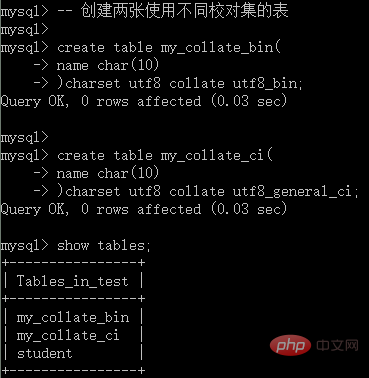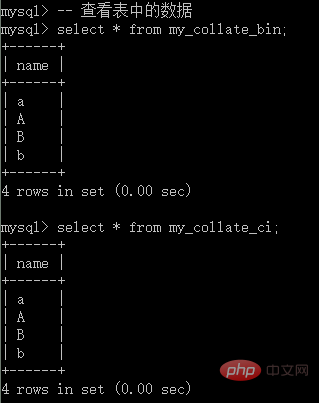MySQL tutorial proofreading set problem
This article mainly introduces you to the proofreading set problem in mysql. I hope it will be helpful to friends in need!
Recommended reference tutorial: "mysql tutorial"
Proofreading set problem
Proofreading set is actually a way of comparing data.
There are three types of proofreading sets, namely:
_bin: binary, binary comparison, case-sensitive;_cs:case sensitive, case sensitive, case sensitive;_ci:case insensitive, case insensitive, not case sensitive.
View (all) proofreading sets–> Basic syntax: show collation;

utf8_bin and _ci for comparison:
-- 创建两张使用不同校对集的表create table my_collate_bin(
name char(MySQL tutorial proofreading set problem)
)charset utf8 collate utf8_bin;create table my_collate_ci(
name char(MySQL tutorial proofreading set problem)
)charset utf8 collate utf8_general_ci;
my_collate_bin and my_collate_ci, and their proofing sets are _bin and _ci## respectively. #. Then, add data to these two tables respectively: <div class="code" style="position:relative; padding:0px; margin:0px;"><pre class='brush:php;toolbar:false;'>-- 向表中添加数据insert into my_collate_bin values (&#39;a&#39;),(&#39;A&#39;),(&#39;B&#39;),(&#39;b&#39;);insert into my_collate_ci values (&#39;a&#39;),(&#39;A&#39;),(&#39;B&#39;),(&#39;b&#39;);</pre><div class="contentsignin">Copy after login</div></div> Then view the data in the two tables respectively:
-- 查看表中的数据select * from my_collate_bin;select * from my_collate_ci;
 Next, we will use the To sort by a certain field (both
Next, we will use the To sort by a certain field (both
and my_collate_ci have only one field), the basic syntax is: <div class="code" style="position:relative; padding:0px; margin:0px;"><pre class='brush:php;toolbar:false;'>order by + 字段名 + [asc/desc];</pre><div class="contentsignin">Copy after login</div></div>where,
means ascending order, desc means descending order, and the default is ascending order. Execute the following SQL statement: <div class="code" style="position:relative; padding:0px; margin:0px;"><pre class='brush:php;toolbar:false;'>-- 排序比较select * from my_collate_bin order by name;select * from my_collate_ci order by name;</pre><div class="contentsignin">Copy after login</div></div></p>
<p><img src="/static/imghw/default1.png" data-src="https://img.php.cn/upload/article/000/000/020/37afd682944343ee0bbf5bb2bfa92eb1-3.png" class="lazy" alt="MySQL tutorial proofreading set problem" title="">As shown in the picture above, obviously the proofreading set is effective! </p>
<p>In addition, we need to pay special attention to the following: </p>The proofing set must be declared before there is no data. If the proofing set is modified after there is data, the modification will be invalid. <p><strong></strong></p>Warm reminder: <p>The content enclosed by the symbols <strong>[]</strong> represents optional options; the symbols <code> represent the meaning of connection
The above is the detailed content of MySQL tutorial proofreading set problem. For more information, please follow other related articles on the PHP Chinese website!

Hot AI Tools

Undresser.AI Undress
AI-powered app for creating realistic nude photos

AI Clothes Remover
Online AI tool for removing clothes from photos.

Undress AI Tool
Undress images for free

Clothoff.io
AI clothes remover

Video Face Swap
Swap faces in any video effortlessly with our completely free AI face swap tool!

Hot Article

Hot Tools

Notepad++7.3.1
Easy-to-use and free code editor

SublimeText3 Chinese version
Chinese version, very easy to use

Zend Studio 13.0.1
Powerful PHP integrated development environment

Dreamweaver CS6
Visual web development tools

SublimeText3 Mac version
God-level code editing software (SublimeText3)

Hot Topics
 1664
1664
 14
14
 1423
1423
 52
52
 1317
1317
 25
25
 1268
1268
 29
29
 1243
1243
 24
24
 When might a full table scan be faster than using an index in MySQL?
Apr 09, 2025 am 12:05 AM
When might a full table scan be faster than using an index in MySQL?
Apr 09, 2025 am 12:05 AM
Full table scanning may be faster in MySQL than using indexes. Specific cases include: 1) the data volume is small; 2) when the query returns a large amount of data; 3) when the index column is not highly selective; 4) when the complex query. By analyzing query plans, optimizing indexes, avoiding over-index and regularly maintaining tables, you can make the best choices in practical applications.
 MySQL: Simple Concepts for Easy Learning
Apr 10, 2025 am 09:29 AM
MySQL: Simple Concepts for Easy Learning
Apr 10, 2025 am 09:29 AM
MySQL is an open source relational database management system. 1) Create database and tables: Use the CREATEDATABASE and CREATETABLE commands. 2) Basic operations: INSERT, UPDATE, DELETE and SELECT. 3) Advanced operations: JOIN, subquery and transaction processing. 4) Debugging skills: Check syntax, data type and permissions. 5) Optimization suggestions: Use indexes, avoid SELECT* and use transactions.
 MySQL: The Ease of Data Management for Beginners
Apr 09, 2025 am 12:07 AM
MySQL: The Ease of Data Management for Beginners
Apr 09, 2025 am 12:07 AM
MySQL is suitable for beginners because it is simple to install, powerful and easy to manage data. 1. Simple installation and configuration, suitable for a variety of operating systems. 2. Support basic operations such as creating databases and tables, inserting, querying, updating and deleting data. 3. Provide advanced functions such as JOIN operations and subqueries. 4. Performance can be improved through indexing, query optimization and table partitioning. 5. Support backup, recovery and security measures to ensure data security and consistency.
 MySQL's Role: Databases in Web Applications
Apr 17, 2025 am 12:23 AM
MySQL's Role: Databases in Web Applications
Apr 17, 2025 am 12:23 AM
The main role of MySQL in web applications is to store and manage data. 1.MySQL efficiently processes user information, product catalogs, transaction records and other data. 2. Through SQL query, developers can extract information from the database to generate dynamic content. 3.MySQL works based on the client-server model to ensure acceptable query speed.
 Explain the role of InnoDB redo logs and undo logs.
Apr 15, 2025 am 12:16 AM
Explain the role of InnoDB redo logs and undo logs.
Apr 15, 2025 am 12:16 AM
InnoDB uses redologs and undologs to ensure data consistency and reliability. 1.redologs record data page modification to ensure crash recovery and transaction persistence. 2.undologs records the original data value and supports transaction rollback and MVCC.
 MySQL: An Introduction to the World's Most Popular Database
Apr 12, 2025 am 12:18 AM
MySQL: An Introduction to the World's Most Popular Database
Apr 12, 2025 am 12:18 AM
MySQL is an open source relational database management system, mainly used to store and retrieve data quickly and reliably. Its working principle includes client requests, query resolution, execution of queries and return results. Examples of usage include creating tables, inserting and querying data, and advanced features such as JOIN operations. Common errors involve SQL syntax, data types, and permissions, and optimization suggestions include the use of indexes, optimized queries, and partitioning of tables.
 MySQL's Place: Databases and Programming
Apr 13, 2025 am 12:18 AM
MySQL's Place: Databases and Programming
Apr 13, 2025 am 12:18 AM
MySQL's position in databases and programming is very important. It is an open source relational database management system that is widely used in various application scenarios. 1) MySQL provides efficient data storage, organization and retrieval functions, supporting Web, mobile and enterprise-level systems. 2) It uses a client-server architecture, supports multiple storage engines and index optimization. 3) Basic usages include creating tables and inserting data, and advanced usages involve multi-table JOINs and complex queries. 4) Frequently asked questions such as SQL syntax errors and performance issues can be debugged through the EXPLAIN command and slow query log. 5) Performance optimization methods include rational use of indexes, optimized query and use of caches. Best practices include using transactions and PreparedStatemen
 Why Use MySQL? Benefits and Advantages
Apr 12, 2025 am 12:17 AM
Why Use MySQL? Benefits and Advantages
Apr 12, 2025 am 12:17 AM
MySQL is chosen for its performance, reliability, ease of use, and community support. 1.MySQL provides efficient data storage and retrieval functions, supporting multiple data types and advanced query operations. 2. Adopt client-server architecture and multiple storage engines to support transaction and query optimization. 3. Easy to use, supports a variety of operating systems and programming languages. 4. Have strong community support and provide rich resources and solutions.




